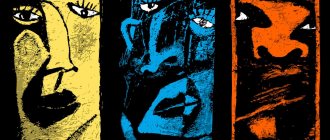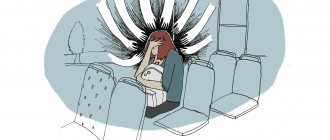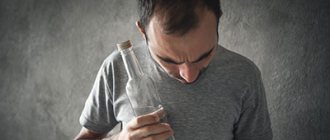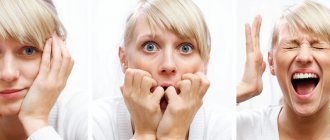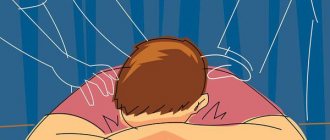Medical information is reliable Checked by Eremin Alexey Valentinovich
Affective disorders, even if they are episodic, greatly affect a person’s quality of life. A depressive episode is most often observed as part of the manifestation of bipolar disorder with a change in the emotional state of the patient. But it can also act as a separate disease. Expressed in the form of sadness, melancholy, and decreased interest in life. The pathology is often accompanied by somatic, cognitive and psychotic symptoms of varying severity.
Depression can occur in different ways, with a predominance of melancholy, apathy or anxiety. In some cases, agitation occurs against a background of low mood. Often such an episode, interspersed with a period of calm or pronounced activity, accompanies chemical dependence and can serve as the first sign of taking psychoactive substances.
Causes of a depressive episode
The main causes of a depressive episode are not fully understood. But there are many scientific hypotheses that explain the development of this affective disorder. The most likely ones are:
- genetic predisposition;
- features of neurochemical processes;
- features of upbringing;
- personal qualities;
- acute or chronic psychotrauma.
As many years of scientific research indicate, the share of internal factors (heredity) in the development of a depressive episode is about 75%. And the influence of the environment does not exceed 25%. Therefore, the likelihood of a deviation occurring against the background of the same stressful situation will be different for each person.
According to scientific data, predisposition to bipolar disorder and depression depends on the presence of a dominant gene that is linked to the X chromosome. Affective disorders also occur due to deficiency of the G6PD enzyme. The likelihood of developing the pathology in a child increases by 50%, even if only one of the parents is a carrier of the gene.
Mental characteristics strongly depend on the environment in which the child grows and develops. Most children raised by parents with mental disorders have a high risk of developing affective disorders. Alcohol or drug addiction in the mother and (or) father and a tendency to unpredictable mood swings also have an impact.
The likelihood of a depressive episode directly depends on a person’s personality characteristics. The following constitutional types of people are at risk:
- asthenic;
- melancholic;
- statothymic;
- depressive.
Character traits such as:
- hypertrophied responsibility;
- pedantry;
- overestimating demands on oneself;
- conscientiousness and diligence;
- high emotional lability;
- lack of personal resources to provide basic needs.
Often a depressive episode develops against the background of an imbalance of hormones responsible for good mood. A constant lack of dopamine, norepinephrine and serotonin leads to mental disorders, including emotional instability and depression. Stressful situations also play an important role. These can be strong one-time shocks or chronic ones that last over a long period. In some cases, depression of mood can be triggered by the change of season and other events. Mild forms of the disease are dealt with by a psychotherapist or psychologist; for people in a state of moderate severity and severe deviations, consultation with a psychiatrist is required.
If a loved one is showing signs of depression, then you should not waste time and wait for everything to go away on its own. The sooner you seek professional help, the better the prognosis will be.
Schizoaffective disorder: causes
Schizoaffective disorder is classified as a so-called third endogenous psychosis. It is, relatively speaking, at the intersection of schizophrenia and bipolar affective disorder (BAD), which according to the old classification is also referred to as manic-depressive psychosis. Or the BALL occupies a place, as it were, at the closest pole to the border with affective psychoses.
Endogenous diseases have a genetic basis, which is already hidden in the prefix “endo”, that is, “internal”. The concept of “endogenous” arose even before genetics appeared. Today, this term has been preserved and denotes a hereditary basis, that is, genetic. The likelihood of developing schizoaffective disorder increases if a person has relatives who have suffered from schizophrenia spectrum diseases.
Previously, it was believed that certain conditions were necessary for genes to “express themselves.” It was assumed that the likelihood of manifestation of certain genes depends on factors affecting the development of the fetus during the prenatal period (hypoxia, starvation, infections). It was also believed that the social environment in childhood and adolescence plays a significant role. But at the present stage it has become clear that all these factors can only be push factors – trigger ones – in the manifestation of the onset of schizophrenia and schizoaffective disorder (recurrent schizophrenia) in particular.
Main symptoms of a depressive episode
A depressive episode should be distinguished from an ordinary bad mood or emotional experience against the background of current circumstances. The main symptoms of deviation are:
- feeling of melancholy, depression;
- lack of joy;
- lack of pleasure from previously enjoyable activities for a person;
- high fatigue, constant fatigue, decreased ability to work.
Additional signs indicating depression may include:
- anxiety;
- tearfulness;
- irritability;
- lack of desires and aspirations;
- social distancing;
- sleep disturbance;
- a feeling of pressure or discomfort in the chest area and in the solar plexus area;
- low self-esteem, hopelessness;
- vision of the future in gloomy colors;
- headache;
- inhibition of thought processes, difficulty in concentrating;
- lack of desire to eat or gluttony;
- difficulties in performing hygiene procedures and performing usual actions;
- thoughts about one’s worthlessness, insignificance, and death.
Symptoms of a depressive episode may manifest differently for each patient. And not all of the above signs are always present. Sometimes it all starts with a normal depressed state, then other deviations are gradually added, indicating the development of depression. The diagnosis is made when the disorder lasts for two weeks or more.
Main factors of occurrence
The etiology of depressive neurosis is always psychogenic (stress due to external or internal factors), and contains the causes of neurosis and depression, as well as part of their symptoms, which often complicates diagnosis in the early stages of development. In addition, the clinical picture of the disorder is complemented by somato-vegetative symptoms, which further complicates diagnosis and differentiation with other pathologies.
Neurotic depression can occur in groups of people with directly opposite psychotypes. The first of them is people who are confident in their beliefs, distinguished by categorical statements, setting new goals and achieving them. At the same time, they hide their inner world from others. A large place in it is given to concerns and worries about personal leadership and the assessment of their actions by those around them.
The second group of people susceptible to neurotic depression includes individuals who poorly adapt to various life complications and even natural changes. They are characterized by low self-esteem, inability to make decisions, daydreaming in the absence of action.
Factors that can cause neurotic disorders such as depression in both groups can be long-term psychotraumatic circumstances: personal failures in professional activities, failures in personal life, social relationships. Among these factors, the most influential are:
- constant suppression of real feelings and emotions, hiding true feelings from others;
- inability to distance yourself from a situation, not to get involved, not to take it to heart;
- an overly heightened sense of responsibility and desire to be the best;
- conflict between the goal and the means to achieve it;
- emotional hunger - the absence of like-minded people, loved ones, friends, relatives, the inability to do what you love, to communicate with the people you want.
The accumulation of these unfavorable factors gives a person the impression that it is impossible to correct the situation; he does not even try to look for ways to solve problems, directing all efforts to hiding the internal conflict. As a result, the nervous system cannot withstand such stress, and the first visible sign of depressive neurosis appears - autonomic-somatic disorders.
Mild depressive episode
A mild form of a depressive episode may begin with somatic disorders. A person suffers from headache, fatigue, fatigue. At first, mood changes are not noticed, concentration decreases and thinking processes become difficult. Usually the patient feels worst in the morning, and by the evening his health improves somewhat.
As it progresses, sleep problems begin, a decrease or increase in appetite, and feelings of anxiety and melancholy appear. If treatment is not carried out, tearfulness and irritability join the general symptoms, and apathy increases. The previous pace of life becomes difficult to maintain. In this case, help can be provided by a psychologist or psychotherapist; therapy is usually carried out on an outpatient basis.
Publications in the media
Emotions constitute an integral component and manifestation of human life. There are only two types of positive emotions: joy and interest. Negative emotions have a wider spectrum than positive ones and are divided into biological (anxiety, fear, suffering, anger and their derivatives) and social (shame, guilt, fear of losing one’s self). A special place among them is occupied by anxiety, which is one of the most ancient evolutionary mechanisms. Its biological significance is that it, as an analogue of an active-defensive reaction, provides the body with preparedness for action in a situation of stress. According to R. May [7], “anxiety is fear in a situation where a value is under threat, which, according to a person’s feeling, is vitally important for the existence of his personality.” In this context, anxiety is natural, adequate, and useful. However, under a number of objective and subjective conditions, anxiety becomes excessively expressed, loses its adaptive nature and is considered pathological (
). Transforming from normal to pathological, anxiety becomes the basis for the formation of anxiety disorders (AD).
Etiopathogenesis and epidemiology of TR
Currently, during times of stress and overload, the prevalence of TD in the population is very high [1, 10]. According to foreign literature, at one time 9% of the world's population suffers from some kind of TR, and almost 25% of people suffer from TR throughout their entire life.
The biological and psychological prerequisites for the formation of TR are considered [2]. Psychological aspects of etiopathogenesis are presented within the framework of various psychological theories. In particular, psychoanalytic theory views anxiety as a signal of the emergence of an unacceptable, forbidden need or impulse that prompts the individual to unconsciously prevent its expression. From the standpoint of behaviorism, anxiety and, in particular, phobias initially arise as a conditioned reflex reaction to painful or frightening stimuli. Cognitive psychology focuses on erroneous and distorted thought patterns that precede the onset of anxiety.
Biological theories take the biological criterion, i.e., the specific state of the brain substrate, as the basis for defining the concept. In this paradigm, any TR is considered as a consequence of cerebral pathological changes, the identification of which is associated with further improvement of diagnostic technologies. In particular, studies of the bioelectrical activity of the brain of patients with TD show differences in the spatial-frequency characteristics of the electroencephalogram (EEG) in individuals with increased levels of anxiety [3, 5]. A study of the level of cerebral metabolism suggests that the basis of the brain support for reactive anxiety is a system whose most stable links are cerebral structures such as the superior parietal associative cortex, the parahippocampal gyrus, the thalamus and caudate nucleus, and the amygdala [2, 12].
The peculiarity of the modern approach to the study of anxiety is the idea of its multifactorial nature, based on the recognition of the unity of the biological, psychological and social components of anxiety.
Classification of anxiety disorders
Existing classifications of TD involve the formation of independent rubrics based on the understanding of anxiety not as a syndrome, but as a separate diagnostic unit. Anxiety and TD are considered in the two most widely used diagnostic systems - ICD-10 and the American DSM-IV-TR.
ICD-10 does not use the traditional differentiation between neuroses and psychoses, which was used in ICD-9. However, the term "neurotic" is retained in the title of the large group of disorders F40-F48 "Neurotic, stress-related and somatoform disorders."
The Diagnostic and Statistical Manual of Mental Disorders DSM-IV-TR (2000) used the term “neurosis” to describe anxiety disorders before the classification was reissued in 1980. However, in the future, a trend of increasing clinical “fragmentation” of TD began to take place, which was reflected in later classification systems of behavioral and mental disorders.
Clinical characteristics of anxiety disorders
The group of TD includes several rather heterogeneous diseases, connected by one common feature - a high level of anxiety, which is persistent in nature, may or may not be limited to any specific circumstances (fixed or unfixed, personal and situational).
Clinically, TR is manifested by mental and somatic (vegetative) symptoms, an important distinguishing feature of which is their polysystemic nature.
The most common mental manifestations of TR are:
- fears (worry about future failures, feelings of excitement, difficulty concentrating, etc.);
- worrying about little things;
- irritability and impatience;
- feeling of tension, stiffness;
- fussiness;
- inability to relax;
- feeling nervous or on the verge of a breakdown;
- inability to concentrate;
- memory impairment;
- fast fatiguability;
- fears;
- obsessive thoughts, images.
Autonomic (somatic) manifestations of anxiety include:
- sweating, cold and wet palms;
- dry mouth;
- feeling of a “lump” in the throat;
- feeling of lack of air;
- muscle tension and pain;
- nausea, diarrhea, abdominal pain;
- dizziness;
- fainting state;
- decreased libido, impotence;
- muscle tension and pain;
- cardiopalmus;
- hot or cold flashes.
A characteristic property of anxiety is not only the anticipation of a particular danger, but also the motivation to search for and specify this danger, which leads to the formation of certain syndromes. The formation of one or another clinical syndrome, i.e., one or another variant of TR, depends on the path followed by the specification (realization) of anxiety.
Characteristics of the main variants of anxiety disorders
Generalized anxiety disorder (GAD) (F41.1) is characterized by anxiety that is generalized and persistent, not limited to any specific environmental circumstances, and does not even occur with a clear preference in those circumstances (i.e., is “unfixed”).
To make a diagnosis, primary anxiety symptoms must be present for at least six weeks. Most often they serve in this capacity:
- restlessness, fussiness, or impatience;
- fast fatiguability;
- disorder of concentration and memory;
- irritability;
- muscle tension;
- sleep disturbance.
Diagnostic criteria for GAD are less clear than for other variants of GAD, and are rather based on the principle of exclusion. According to most researchers, GAD does not represent a single diagnostic category, but rather reflects a special disturbing phenomenon that occurs with different diagnoses.
The remaining TRs, classified under other headings and subcategories, are essentially determined by the above criteria (most of them or only part) and additional criteria that determine the specifics of a particular TR.
The main feature of panic disorder (F41.0) is periodically recurring panic attacks that occur spontaneously, suddenly, without any visible connection with external stimuli (“like a bolt from the blue”), last 5–30 minutes and are accompanied by symptoms such as shortness of breath, palpitations , dizziness, choking, chest pain, trembling, increased sweating and fear of dying or going crazy. Attacks often occur in a situation where patients are restricted in their freedom of movement or in a room from which they cannot escape and where they cannot get help.
Panic disorder is often accompanied by agoraphobia. Currently, this term is interpreted more broadly than before, and includes fear not only of open spaces, but also of any situations from which it is not possible to immediately get out and return to a safe place. Although agoraphobia is considered a separate disorder, it often serves as a defense mechanism for panic disorder: by staying at home or leaving it only with an accompanying person, sufferers thereby avoid stress, reducing the likelihood of an attack.
Phobic anxiety disorder (F40) clinically manifests itself as overvalued fears that are not justified by a specific threat or do not correspond to its level of significance.
The following are the characteristic properties of phobias:
- expressed and persistent or unreasonable fear associated with the presence or expectation of a specific object or situation;
- immediate phobic reaction to an alarming stimulus;
- the patient’s awareness of the excessiveness and irrationality of fear;
- avoidance of phobic situations;
- pronounced distress associated with awareness of the phobia.
The topics of phobias are varied. One of the most common types of phobias - nosophobia (fear of illness, for example, cancerophobia) - is often provoked by the illness of someone you know. Even a thorough medical examination rarely brings relief.
Agoraphobia (F40.0) is specific to the fear of being in a crowd of people, in a public place, or on any trip, especially on your own. As mentioned earlier, agoraphobia can accompany panic attacks, but can also occur without them.
Social phobia (F40.1) - severe fear of being the center of attention or fear of behaving in a way that causes embarrassment or humiliation in certain situations, such as socializing or eating in public, public speaking, meeting familiar faces in public, visiting public restrooms, being in small groups (e.g., parties, meetings, classrooms), etc.
The defining criterion for specific (isolated) phobias (F40.2) is fear within a strictly limited situation or strictly defined objects (heights, snakes, spiders, airplane flights, etc.). As with social phobias, avoiding significant situations in some cases helps patients adapt quite successfully to everyday life.
Obsessive-compulsive disorder (F42) includes compulsions, which often lead to the formation of obsessive actions and rituals (compulsions). Obsessions are ideas, thoughts, or impulses that persistently and persistently pursue a person and that are perceived as painful and unpleasant, such as blasphemous thoughts, thoughts about murder, or thoughts about sex. They are characterized by the following signs:
- perceived as intrusive and inappropriate;
- are not the result of excessive worry about real problems;
- accompanied by an unsuccessful desire to suppress, avoid, ignore them, or neutralize them with other thoughts or actions;
- are recognized by the patient as a product of his own psyche.
Compulsivity is a repetitive, goal-directed, and intentional behavior that occurs as a reaction to compulsions in order to neutralize or prevent psychological discomfort.
Examples include obsessive thoughts about dirt and pollution, leading to compulsive washing and avoidance of “polluting” objects, pathological counting, and compulsive checking, such as repeatedly checking that the gas is off, or returning to the same street to make sure no one is there. crushed, etc.
Post-stress anxiety within post-traumatic stress disorder (F43.1) develops after life-threatening situations or disasters (military operations, nuclear power plant accident, car accident, fire, flood, rape). Characterized by persistent painful memories, increased excitability, irritability and outbursts of anger, sleep disturbances and nightmares, including pictures of the experienced situation, feelings of loneliness and mistrust, a feeling of inferiority, avoidance of communication and any activities that may remind of the events that occurred.
Mixed anxiety and depressive disorder (F41.2) is diagnosed when the patient has symptoms of both anxiety and depression, but neither one nor the other is clearly dominant or severe.
Within the framework of specific personality disorders (F60) (it should be remembered that pronounced personality disorders are psychopathy familiar to the Russian-speaking reader), anxious (“avoidant”, “avoidant”) personality disorder (F60. 6). To some extent, it resembles a sensitive type of psychopathy, which was not always distinguished in Russian classifications. From early childhood, patients are characterized as timid, shy people with low self-esteem. An exaggerated fear of arousing even a slight critical attitude leads them to avoidant behavior.
In its clinical picture, dependent personality disorder (F60.7) is very close to the anxious type. It, like the previous one, was also borrowed from the DSM and was absent from classical Russian and German psychiatry. Self-doubt, fear of displaying any noticeable reactions (especially sexual and aggressive) are combined with expressed anxiety, fear of being abandoned by a significant person.
Features of the manifestation of anxiety in childhood are:
- prevalence of obsessive-phobic disorders;
- more pronounced somatization of anxiety;
- pronounced behavioral disorders: limited contact, fussiness, restlessness, aggressiveness;
- self-doubt, low self-esteem;
- constant need for adult support;
- the presence of specific variants of anxiety disorders in children.
Specific TDs of childhood are presented in the heading F93 “Emotional disorders of childhood.” Most of them are essentially exaggerations of normal trends in the process of development, rather than qualitatively new phenomena. An example is separation anxiety disorder in childhood (F93.0). Such children do not develop skills of independent behavior and the fear of separation acquires exaggerated proportions. Anxiety in a child can take the following forms:
- persistent, unrealistic fear of misfortune that could happen to the main person in his immediate environment, or fear that his parents will leave him and not return;
- an unrealistic fear that some untoward event will separate the child from the person for whom great affection is felt;
- refusal to go to sleep alone or away from home for fear of losing a significant person;
- recurring nightmares about separation;
- reappearance of somatic disorders in situations related to separation;
- recurrent distress (anxiety, crying, irritation, apathy, withdrawal, etc.).
The Pediatric Phobic Anxiety Disorder rubric can only be used for developmentally specific fears that meet the criteria of the F93 rubric:
- onset at a developmentally appropriate age;
- the degree of anxiety is excessively expressed and causes a clear decrease in social adjustment;
- anxiety is not part of a more generalized disorder.
Childhood social anxiety disorder (F93.2) is used only for disorders that occur before age 5 years and do not correspond to typical age-specific presentations. Noteworthy is the pronounced difference between behavior at home and in non-family social situations, which is accompanied by problems of social functioning.
Treatment of Anxiety Disorders
Experience with patients suffering from TD inevitably leads clinicians to the conclusion that an integrated approach combining psychotherapy, psychopharmacotherapy and social-environmental influence is maximally effective (
).
The main method in a complex therapeutic complex for TR is psychotherapy [4, 11]. Currently, a psychotherapist has a large arsenal of tools at her disposal, ranging from simple ones that solve the problem of symptomatic improvement to complex ones aimed at resolving the patient’s internal conflicts. Most psychotherapy regimens are based on the assumption that anxiety is caused by an exaggerated assessment of the threat or an incorrect interpretation of one's own state of increased activation. In this case, either the external danger is overestimated or one’s own abilities to cope with it are underestimated. Anxious fears and a feeling of helplessness arise, in which increased attention is paid to one’s internal state. Increased alertness leads to a narrowing of attention and a decrease in its concentration, as well as to violations of self-control and correct response. The most important goal of psychotherapy is to gradually bring patients to an awareness of the essence of their psychological conflict and then to a gradual modification of previous inadequate patterns and attitudes and, ultimately, the development of a new, more harmonious and flexible system of views and relationships, more mature adaptation mechanisms, restoration of self-control and adequate response. The content of the main psychotherapeutic methods effective in working with anxiety disorders is given in
.
All of the above methods are equally effective for various types of TR, however, it is worth noting that certain techniques are more preferable and, in a certain sense, specific for specific forms of TR (
).
Psychopharmacotherapy plays a special role in the treatment of TR (
). Currently, there is a rich arsenal of anti-anxiety drugs that can influence not only mental, but also somatic manifestations of anxiety.
The formation of anxiety is based on an imbalance of certain mediators: serotonin, norepinephrine and GABA. Anti-anxiety drugs mainly realize their effect through these mediator systems. Among GABAergic anxiolytics, the leading place is occupied by benzodiazepine tranquilizers. The main advantages of benzodiazepine anxiolytics are the rapid and real achievement of a therapeutic effect. Among the disadvantages of treatment with benzodiazepines, the following should be mentioned: “recoil” syndrome (rapid resumption or transient increase in symptoms after discontinuation of the drug), the risk of addiction and the formation of drug dependence, impaired cognitive functions (attention, concentration, memory), and impaired coordination. Therefore, benzodiazepine drugs should not be taken for longer than 2–4 weeks.
In connection with the above “benzodiazepine” problems, a new generation of non-benzodiazepine anxiolytics is being widely introduced into clinical practice. These include, in particular, blockers of histamine H1 receptors: tofisopam (Grandaxin), which has an anxiolytic effect, is a psychovegetative regulator, and also does not have a sedative and muscle relaxant effect, and hydroxyzine (Hidroxyzine, Atarax), which has a rapid onset of effect, absence of addiction and drug dependence, does not impair cognitive functions, has antipruritic and antiemetic effects.
Other non-benzodiazepine anxiolytics include the azapirone drug buspirone (Spitomin) and Afobazole (prevents the development of membrane-dependent changes in the GABA receptor).
Tricyclic antidepressants, selective serotonin reuptake inhibitors (SSRIs), and dual-acting antidepressants act on anxiety through the serotonergic systems.
The first-line drugs for the treatment of anxiety disorders are benzodiazepine tranquilizers and SSRIs; tricyclic antidepressants and non-benzodiazepine anxiolytics are considered second-line drugs.
In some cases, a positive effect in the treatment of anxiety is achieved with the use of antipsychotics - thioridazine (Sonapax), sulpiride (Eglonil), tiapride (Tiaprid), etc. However, it should be remembered that when prescribing antipsychotics, weakness, decreased blood pressure, menstrual irregularities, weight gain, colostrum secretion, decreased libido.
Beta-adrenergic blockers (such as propranolol and atenolol) are especially effective when the autonomic component of TR is pronounced, as they block the physical symptoms of chest pain, throat constriction and shortness of breath without having a sedative (relaxing) effect.
In some cases, psychotropic drugs may be poorly tolerated by patients due to side effects, which ultimately neutralizes their therapeutic effectiveness. Official herbal preparations, which have significantly fewer side effects, can be considered as an alternative therapy or used to enhance the effectiveness of prescription drugs. The main indication for the use of this category of drugs is short-term subsyndromal or “undeveloped” (mild) anxiety disorders.
Among the herbal medicines used by clinicians to treat subthreshold anxiety, the drug Novo-Passit has become widespread, which has shown its effectiveness, the possibility of use in a wide variety of age groups [6, 8], the absence of any side effects, high anxiolytic activity and, finally, , which is very important, its availability. The active components of the drug are dry extracts of medicinal plants with pronounced sedative activity (hops, St. John's wort, lemon balm, passionflower, elderberry, valerian, hawthorn) and guaifenesin, which has a pronounced anxiolytic effect.
Due to its unique composition, Novo-Passit is often prescribed to children and adults with various forms of anxiety disorders. The sedative and anxiolytic effect of the drug helps eliminate anxiety and associated autonomic symptoms: sleep disorders, muscle tension, headaches and asthenia. The drug is non-toxic, safe and non-addictive.
Homeopathic anti-anxiety medications have become another alternative to medications. These drugs include Tenoten, which contains fine regulators - antibodies to the S-100 protein contained in the parts of the brain responsible for an adequate emotional response. As a result, its GABA-mimetic effect is realized and GABAergic neurotransmission is restored. The clinical effect is manifested by a decrease in anxiety and improvement in cognitive functions [9].
The choice of psychotropic drug depends on the characteristics of the TR:
- degree of severity of anxiety level;
- duration of the disease (acute, chronic);
- type of course (paroxysmal or permanent disorders).
As the clinical picture becomes more complex and anxiety becomes chronic, priority is increasingly given to antidepressants or combination therapy.
Among other drugs used in the treatment of TR, one can note drugs that improve hemodynamic and metabolic processes in the central nervous system (piracetam (Nootropil), gamma-amino-butyric acid (Aminalon), for children - hopantenic acid (Pantogam)). These drugs, having a direct activating effect on the integrative mechanisms of the brain, stimulate cognitive processes, increase the brain’s resistance to “aggressive” influences, improve cortico-subcortical connections, facilitate the transfer of information between the hemispheres, and improve synaptic transmission in brain structures. In solving this problem, the drugs Neuromultivit and Enerion, which act on the structures of the reticular formation and have a stimulating effect, have proven themselves well.
Currently, material is accumulating in world clinical practice indicating that specially selected “afferent (sensory) inflows” help optimize autonomic regulation in various pathological conditions, in particular in TR (Gudzzetta CE, 1989; Malyarenko T.I. and co-authors, 1998, 2000; Zavyalov A.V., 2000; Govsha Yu.A., 2003). To solve these problems, acoustic (music), olfactory (smells), visual and other sensory inputs are used, as well as combined forms of psychosensory influence in the complex therapy of TD. In the complex of TR therapy, other methods based on physiogenic effects are also used: reflexology, massage.
Based on the above, it seems important to increase the awareness of general specialists about the features of diagnosis and treatment of TR. Modern approaches to the treatment of TD are based on an integrative approach, combining psychotherapy, psychopharmacotherapy and social-environmental influence. ЃЎ
Moderate depressive episode
Moderate depression is accompanied by a pronounced decrease in mood, melancholy, anxiety and a pessimistic mood predominate. The previous work is difficult to perform, and insomnia or constant drowsiness, severe loss of appetite, and weight changes appear.
The patient begins to feel very burdened by his condition, and changes in appearance are observed. From the outside, fatigue, depression, and lack of energy become noticeable. Symptoms include somatic manifestations, internal anxiety, apathy, and sometimes a person does not experience any emotions at all. In this case, psychiatric care is required on an outpatient basis or in a day hospital.
Differences between males and females
If you believe the statistics, men get sick less often than women. Ratio: 3:2. The female part of the patients is characterized by a rapidly cyclical nature of the disorder. Women have low sensitivity to therapeutic methods. They have a higher risk of suicidal behavior and a higher rate of hospitalization. The symptoms of bipolar disorder in men are practically no different from the manifestations of the disorder in women.
Minor differences - in the male part of the patients the phases of mania and hypomania predominate, and in the female part - depressive states. Symptoms of depression in women are much more pronounced.
Severe depressive episode
A severe form of a depressive episode is expressed in persistent painful sensations. The patient physically experiences discomfort in the precordial region, describes it as petrification, compression. There are no daily mood swings, and the ability to communicate is lost.
The patient practically does not get out of bed, moves very slowly, the face turns into a mask due to poor facial expressions or expresses suffering. Such a person’s speech is either absent or becomes barely audible and indistinct. Hypochondriacal ideas, thoughts about one’s own insignificance, the need for isolation, feelings of guilt and a desire to be punished often appear.
No activity is possible in this state. The likelihood of suicide is very high, especially at the stage of emerging from a deep depressive episode, when painful feelings persist and strength begins to appear. Sometimes a severe depressive episode is accompanied by delusions, hallucinations, or stupor. Such forms of deviation require the patient to be placed in a psychiatric department under constant supervision of specialists. Only in this case is it possible to avoid suicide attempts and select supportive therapy.
Schizoaffective disorder: difference from schizophrenia
Schizoaffective disorder is an endogenous psychosis, without a progressive (progressive) course, in contrast to schizophrenia, which is a chronic progressive mental illness that destroys the personality. ORB is characterized not by continuous, but by periodic manifestations of pathology. In the patient’s life, episodes of psychosis occur (exacerbations, attacks), which can go away on their own without treatment. The rest of the time the patient exists safely, because the schizophrenic defect grows extremely slowly, which practically does not lead to social maladjustment.
Recurrent depressive episode
A recurrent depressive episode is noted in the case of periodic repetition of affective attacks with symptoms typical for this deviation. They may be considered a mental illness in their own right, or they may manifest as clinical depression, bipolar disorder, or another personality disorder. Experts distinguish several types of recurrent depression:
- anxious;
- asthenic;
- apathetic;
- premenstrual;
- seasonal.
In the anxious form, the patient experiences simultaneous signs of anxiety and depressed mood. The pathology is often combined with panic attacks and phobias. The asthenic type of deviation manifests itself in the form of a strong loss of strength and a feeling of constant fatigue. In the apathetic variant, complete loss of interest in life and psychomotor retardation predominate.
Premenstrual depressive episodes occur in women with some regularity and are triggered by hormonal changes. It begins a week before the start of menstruation and lasts no more than 10 days. It is not characterized by a severe course. The seasonal type of deviation is usually observed in spring and autumn. Experts believe that the pathology is based on a lack of vitamin D in the body, without which normal production of serotonin is impossible.
Dr. Isaev’s clinic has all the conditions to provide effective assistance for depressive episodes of any severity. Dial our number and call a specialist at home or make an appointment.
Diagnostics
Diagnosis is carried out by psychiatrists. This is an important step before treating the disorder, since the symptoms of many mental disorders are similar to each other. To exclude or confirm organic lesions, MRI of the head, radiography, and electroencephalography are prescribed. The diagnosis is made according to the criteria of the ICD disorder according to the categorical division of symptoms.
An episode of a mood disorder is considered to be a condition in which the mood disorder is expressed to a certain degree and for a certain time: depression - 2 weeks; mania – 1 week. According to researchers FK Goodwin, KR Jamison (in 1990), 65-70% of initially established psychiatric diagnoses are erroneous - other diseases are easily confused with bipolar disorder. The consequence is the prescription of incorrect drug treatment, aggravation of the course of MDP.
The diagnosis of manic stage is established if the person being examined has at least three of the following symptoms:
- delusions of grandeur;
- excessively low need for sleep;
- previously unusual incoherence of speech;
- uncontrolled flow of ideas;
- previously unusual distractibility;
- psychomotor stimulation;
- interest in activities with increased risk to life or health;
- problems in labor, educational, social functioning of the individual.
The psychiatrist determines the severity of the disorder: mild, moderate or severe with psychotic symptoms. According to research by authors RM Hirschfield et al., (2003), G. Perugi (2010), affective disorder is more often confused with depression (60%), anxiety disorder (26%), schizophrenia (18%), personality disorders (17%) , addiction to psychoactive substances (14%).
To establish the correct diagnosis, pay attention to the following points:
- with bipolar disorder, there is an unstable mental response to treatment with antidepressant drugs;
- in case of bipolar disorder, depression and anxiety are initially not combined with the use of psychoactive substances;
- psychotic symptoms develop at a previously normal level of social adaptation;
- family history is likely to include mood disorders or other mental pathologies.
The complexity of diagnosis is based on the fact that the symptom complex of bipolar disorder in its depressive phase is in many ways similar to clinical depression. Differences between bipolar depression and its other types: appetite disorder of the hyperphagia type, the presence of hypersomnia, mild psychotic manifestations. Bipolar disorder is also differentiated from classical depression by the fact that manifestations are noticeable in childhood and develop faster.
Treatment of a depressive episode in Moscow
A depressive episode should be treated taking into account a number of factors; the effectiveness of assistance will depend on a correctly established diagnosis, accurate selection of medication, and determination of the minimum required dosage to relieve symptoms. When prescribing therapy, a specialist always takes into account not only the underlying disease, but also the presence of concomitant pathologies (neurological and somatic).
Upon admission to Dr. Isaev’s clinic, a person undergoes a full diagnosis and comprehensive examinations. This will allow you to determine the cause that caused the depressive episode and create an adequate treatment plan. If necessary, doctors of other specialties are invited to conduct consultations: cardiologists, endocrinologists, neurologists. Psychotherapists and clinical psychologists take an active part both at the stage of diagnosing the disease and after relief of the acute condition. They provide training to improve cognitive function and social communication.
Our specialists approach each patient as an individual, each with their own problems. After correctly selected tactics of helping a patient with a depressive episode, his condition noticeably improves within 2-3 weeks after the start of treatment.
Treatment of recurrent depression
Only contacting a psychotherapist or psychiatrist allows you to make a correct diagnosis and assess the severity of symptoms. Treatment is selected individually. It depends on how the episode progresses, how often they occur, and how many months they last.
Pharmacotherapy
Antidepressants are prescribed only when necessary. The dose and medication are selected taking into account your medical history and health status. Typically the duration is several months. The use of pharmacotherapy can speed up the healing process and minimize the possibility of recurrent episodes.
Psychotherapeutic techniques
Conducting psychotherapy helps to identify negative attitudes in the patient’s thinking and replace them with more positive, constructive ones. The patient learns to see the connection between life events and his emotional experiences. This helps to become aware of your feelings and express them “without going into a depressive state” (or these skills help subsequently reduce the depth of the depressive state).
For recurrent depression, treatment includes drug preventive or remission maintenance therapy. It is recommended in the following cases:
- in chronic or severe forms of the disease;
- if depressive episodes last more than 4-6 months;
- the intervals for complete recovery are reduced;
- the debut occurred at a young or old age.
The practical experience of the doctor is of great importance, since recurrent depression must be able to be distinguished from other mood disorders. The sooner a person seeks help, the easier it will be to cope with the disease.
Drug therapy
Treatment of a depressive episode at Dr. Isaev’s clinic is carried out comprehensively. At the same time, an individual approach is taken to each patient. The main methods of providing assistance are medication and psychotherapy. Most often, to eliminate symptoms of low mood, the following are used:
- neuroleptics;
- antidepressants;
- anxiolytics;
- sleeping pills.
These drugs cannot be taken independently; only a specialist prescribes them, taking into account all the characteristics of a person’s personality, the presence of concomitant diseases, and drug tolerance. Uncontrolled treatment with these drugs can lead to worsening of the condition and the development of severe complications.
Psychotherapy
Psychotherapy is used to treat a depressive episode without fail; it helps speed up recovery and reduce the time of taking medications. In cases of mild illness, work with a specialist is carried out without prescribing potent drugs. To improve the condition, individual and group sessions are used; the following psychotherapy techniques are most often used:
- interpersonal;
- cognitive-behavioural;
- psychodynamic;
- existential;
- art therapy;
- behavioral;
- interpersonal;
- Gestalt therapy;
- NLP.
As a result of individual lessons, a person receives complete information about the characteristics of his disease and ways to improve his condition. The psychotherapist determines the causes of the problem and negative attitudes, changes the patient’s picture of the world, revealing to him the opportunity to see the world in its best manifestations. Group therapy allows you to optimize or acquire social skills and give the patient hope for a full recovery. In such classes you can get the support and approval of others, a positive example of those who have already been able to overcome their depressive state. Such an experience has a positive effect on mood levels and speeds up the process of recovery and return to society.
Doctors at our clinic use only certified medications and modern methods of psychotherapy. All treatments for a depressive episode are safe and effective.
Family psychotherapy is especially important if the cause of the deterioration of the patient’s mood is a negative environment at home and destructive contacts with loved ones. Thanks to the work of a specialist, conflicts among relatives cease, normal attitudes and a favorable atmosphere are restored. Educational work is carried out for all family members, which helps them correctly navigate the situation, gain behavioral and response skills, so as not to provoke a relapse of depression in the person.
Cure prognosis
TDR of physiological etiology is easily eliminated during the treatment of the underlying disease, with the exception of irreversible forms of brain damage. The difficulty is in the treatment of anxious depression caused by personal and psychological factors. In this case, early intervention and the assistance of the patient’s immediate environment play a decisive role.
Carrying out a full course of complex therapy helps to remove anxiety and normalize the general emotional mood, but to ensure the absence of relapses, patients are recommended to work on developing stress resistance so that an unexpected “blow of fate” does not provoke a new attack of anxiety and depression.
Share this article
Questions and answers
Is it possible to completely cure a depressive episode on your own?
Depressive episodes respond well to treatment, but only if they are identified in a timely manner and with the help of special techniques. Trying to fix the problem yourself is doomed to failure. Taking medications without the supervision of a specialist will, at best, lead to zero results, and at worst, it may result in aggravation of the pathological condition.
What happens if depression is not treated?
Ignoring such affective disorders can provoke complications in the form of prolonged depression and the development of serious diseases associated with mental disorders. The person will not be able to work or do household chores, will become a social outcast, and his life may end as a result of suicide.
Suicide due to depression
The most severe and tragic result of depression is suicide. Of the fifteen to twenty million suicide attempts, about half occur among people with depressive mental disorders. In general mortality statistics, completed suicide as a result of depression is in eighth place, behind such pathologies as coronary heart disease, pneumonia, oncology, as well as accidents (road accidents, fires).
One in seven people with depression have attempted suicide. If we take into account tendencies towards suicide, self-destruction and an increased risk of somatic diseases (hypertension, angina, dermatological and endocrine diseases), then depressive disorder shortens a person’s life by about 10 years.


